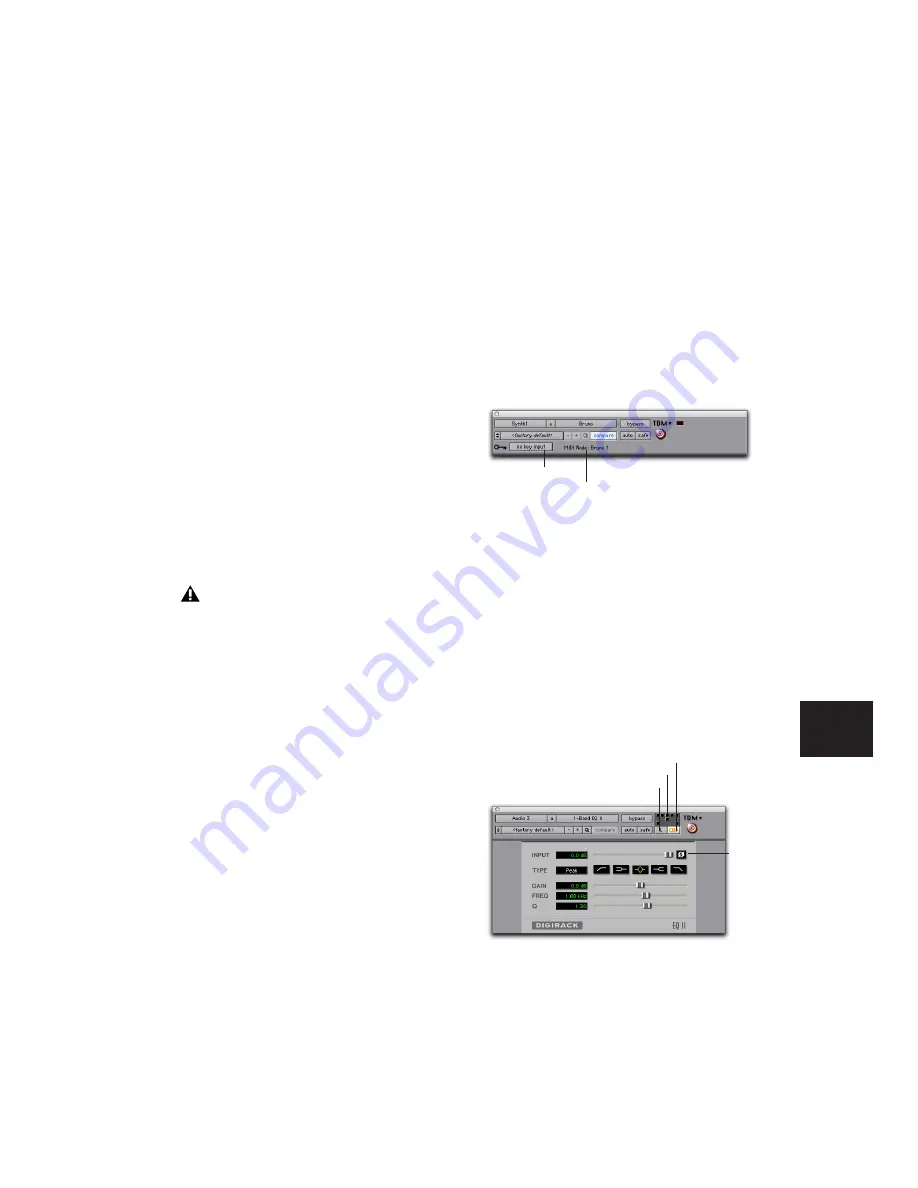
Chapter 29: Plug-in and Hardware Inserts
673
Convert Plug-in Selector
Lets you convert the in-
sert from a TDM plug-in to an RTAS plug-in of
the same type (or vice-versa). This feature can
only be used on plug-ins that are available in
both TDM and RTAS formats.
Clip LED
Lights red to indicate if any meter in a
plug-in has clipped (not available on all plug-
ins). The Plug-in Clip LED follows Pro Tools set-
tings for clip indication.
Ω
Settings Menu
Lets you copy, paste, save, and
import plug-in settings.
Librarian Menu
Recalls settings files saved in the
plug-in’s root settings folder or in the current
session’s Settings folder. See “Using the Librar-
ian” on page 675.
Next (+) and Previous (–) Setting Buttons
Let
you select the next or previous plug-in setting
from the Librarian menu.
Plug-ins Settings Select Button
Accesses the
Plug-in Settings dialog, which lists the settings
files for the current plug-in. From this list, you
can select a new setting, or audition a series of
settings.
Compare
Toggles between the original saved
plug-in setting and any changes you have made
to it so you can compare them.
Auto Button
Lets you enable individual plug-in
controls for automation recording. See “Auto-
mating Plug-ins” on page 703.
Automation Safe
When enabled, prevents exist-
ing plug-in automation from being overwritten.
Target Button
When multiple Plug-in windows
are open, clicking this button selects that plug-
in as the target for any computer keyboard com-
mands. For more information, see “Targeted
Windows” on page 649.
Key Input Selector
Lets you select audio on a
particular input or bus and route it to trigger the
plug-in. This menu only appears on plug-ins
that feature side-chain processing. Key inputs
are monophonic.
MIDI Node Display
Shows MIDI node informa-
tion for MIDI-enabled plug-ins. MIDI nodes are
virtual connections from Pro Tools to software
instruments and other MIDI-enabled plug-ins.
MIDI nodes are useful for routing multiple MIDI
tracks to different channels of a single virtual
MIDI device. MIDI node numbers are also dis-
played in a track’s MIDI Output selector.
Master Link Button
When enabled, links the
controls on all channels of a multi-mono plug-
in so that they can be adjusted in tandem.
You will lose the current settings if they are
not saved before you use the Next and Pre-
vious Setting buttons. Always save your set-
tings to the Librarian menu.
MIDI node display in a plug-in header (Bruno shown)
Plug-in window (multi-mono 1-Band EQ shown)
MIDI node
Key Input selector
Channel Selector
Link Enable buttons
Master Link button
Phase
Invert
Summary of Contents for Pro Tools
Page 1: ...Pro Tools Reference Guide Version 7 3 ...
Page 15: ...1 Part I Introduction ...
Page 16: ...2 ...
Page 33: ...19 Part II System Configuration ...
Page 34: ...20 ...
Page 44: ...Pro Tools Reference Guide 30 ...
Page 94: ...Pro Tools Reference Guide 80 ...
Page 95: ...81 Part III Sessions Tracks ...
Page 96: ...82 ...
Page 108: ...Pro Tools Reference Guide 94 ...
Page 130: ...Pro Tools Reference Guide 116 ...
Page 269: ...255 Part IV Recording ...
Page 270: ...256 ...
Page 310: ...Pro Tools Reference Guide 296 ...
Page 345: ...331 Part V Editing ...
Page 346: ...332 ...
Page 402: ...Pro Tools Reference Guide 388 ...
Page 496: ...Pro Tools Reference Guide 482 ...
Page 548: ...Pro Tools Reference Guide 534 ...
Page 571: ...557 Part VI MIDI Editing ...
Page 572: ...558 ...
Page 596: ...Pro Tools Reference Guide 582 ...
Page 637: ...623 Part VII Mixing ...
Page 638: ...624 ...
Page 702: ...Pro Tools Reference Guide 688 ...
Page 771: ...757 Part VIII Video Sync Surround ...
Page 772: ...758 ...
Page 792: ...Pro Tools Reference Guide 778 ...
Page 806: ...Pro Tools Reference Guide 792 ...
Page 856: ...Pro Tools Reference Guide 842 ...






























